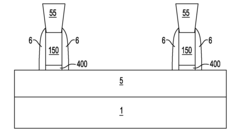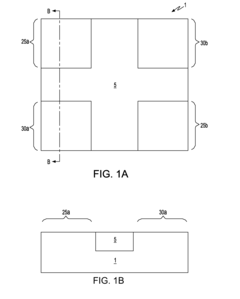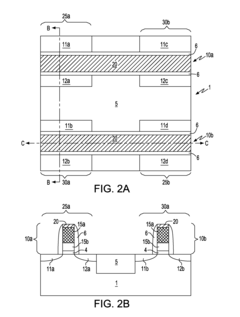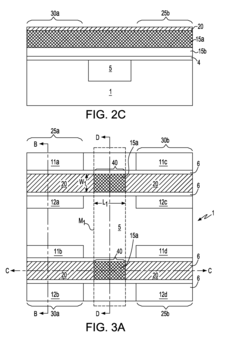How CMOS Battery Facilitates Next-gen Interactive Device Platforms?
JUL 22, 20259 MIN READ
Generate Your Research Report Instantly with AI Agent
Patsnap Eureka helps you evaluate technical feasibility & market potential.
CMOS Battery Evolution
The evolution of CMOS battery technology has played a crucial role in shaping the landscape of interactive device platforms. Initially developed in the 1980s, CMOS (Complementary Metal-Oxide-Semiconductor) batteries were primarily used to maintain basic system settings and real-time clock functions in personal computers. However, their application has since expanded significantly, becoming an integral component in a wide range of electronic devices.
In the early stages, CMOS batteries were simple coin-cell lithium batteries with limited capacity and functionality. As interactive devices became more sophisticated, the demands on CMOS batteries increased, driving innovations in energy density, longevity, and integration capabilities. The late 1990s and early 2000s saw the introduction of rechargeable CMOS batteries, which allowed for longer device lifespans and reduced maintenance requirements.
The miniaturization trend in electronics has been a key driver in CMOS battery evolution. As devices became smaller and more portable, CMOS batteries had to adapt, leading to the development of ultra-thin and flexible battery technologies. This advancement enabled the integration of CMOS batteries into wearable devices and other form factors that were previously impossible.
Another significant milestone in CMOS battery evolution was the integration of power management systems. These intelligent systems optimized power consumption, extending battery life and improving overall device performance. The incorporation of advanced materials, such as graphene and carbon nanotubes, further enhanced the energy density and charging capabilities of CMOS batteries.
The rise of Internet of Things (IoT) devices in the 2010s presented new challenges and opportunities for CMOS battery technology. The need for long-lasting, low-power batteries to support a vast network of connected devices spurred innovations in energy harvesting and ultra-low-power CMOS designs. This led to the development of CMOS batteries capable of operating for years without replacement, a critical feature for many IoT applications.
Recent advancements in CMOS battery technology have focused on sustainability and environmental concerns. Researchers have explored bio-degradable materials and eco-friendly manufacturing processes to reduce the environmental impact of battery production and disposal. Additionally, efforts to improve recycling techniques for CMOS batteries have gained traction, aligning with global initiatives for more sustainable technology.
The integration of artificial intelligence and machine learning algorithms into power management systems represents the latest frontier in CMOS battery evolution. These smart systems can predict power usage patterns, optimize charging cycles, and extend battery lifespan through adaptive power management strategies. This convergence of AI and battery technology is paving the way for more efficient and responsive interactive device platforms.
In the early stages, CMOS batteries were simple coin-cell lithium batteries with limited capacity and functionality. As interactive devices became more sophisticated, the demands on CMOS batteries increased, driving innovations in energy density, longevity, and integration capabilities. The late 1990s and early 2000s saw the introduction of rechargeable CMOS batteries, which allowed for longer device lifespans and reduced maintenance requirements.
The miniaturization trend in electronics has been a key driver in CMOS battery evolution. As devices became smaller and more portable, CMOS batteries had to adapt, leading to the development of ultra-thin and flexible battery technologies. This advancement enabled the integration of CMOS batteries into wearable devices and other form factors that were previously impossible.
Another significant milestone in CMOS battery evolution was the integration of power management systems. These intelligent systems optimized power consumption, extending battery life and improving overall device performance. The incorporation of advanced materials, such as graphene and carbon nanotubes, further enhanced the energy density and charging capabilities of CMOS batteries.
The rise of Internet of Things (IoT) devices in the 2010s presented new challenges and opportunities for CMOS battery technology. The need for long-lasting, low-power batteries to support a vast network of connected devices spurred innovations in energy harvesting and ultra-low-power CMOS designs. This led to the development of CMOS batteries capable of operating for years without replacement, a critical feature for many IoT applications.
Recent advancements in CMOS battery technology have focused on sustainability and environmental concerns. Researchers have explored bio-degradable materials and eco-friendly manufacturing processes to reduce the environmental impact of battery production and disposal. Additionally, efforts to improve recycling techniques for CMOS batteries have gained traction, aligning with global initiatives for more sustainable technology.
The integration of artificial intelligence and machine learning algorithms into power management systems represents the latest frontier in CMOS battery evolution. These smart systems can predict power usage patterns, optimize charging cycles, and extend battery lifespan through adaptive power management strategies. This convergence of AI and battery technology is paving the way for more efficient and responsive interactive device platforms.
Interactive Device Market
The interactive device market has experienced significant growth and transformation in recent years, driven by advancements in technology and changing consumer preferences. This market encompasses a wide range of products, including smartphones, tablets, wearables, smart home devices, and augmented reality (AR) / virtual reality (VR) systems. The global interactive device market size was valued at $372.1 billion in 2020 and is projected to reach $621.4 billion by 2027, growing at a CAGR of 7.6% during the forecast period.
Smartphones continue to dominate the interactive device market, accounting for the largest share of revenue. However, emerging categories such as smart home devices and wearables are experiencing rapid growth. The smart home device market, in particular, is expected to grow at a CAGR of 25.3% from 2021 to 2028, driven by increasing consumer adoption of voice-controlled devices and smart appliances.
The wearables segment, including smartwatches and fitness trackers, has also seen substantial growth. The global wearable technology market size was valued at $32.63 billion in 2019 and is projected to reach $74.03 billion by 2026, growing at a CAGR of 13.8% during the forecast period. This growth is fueled by increasing health consciousness among consumers and the integration of advanced features such as ECG monitoring and fall detection in smartwatches.
The AR/VR market is another rapidly expanding segment within the interactive device landscape. The global AR and VR market size is expected to grow from $30.7 billion in 2021 to $296.9 billion by 2024, at a CAGR of 46.4%. This growth is driven by increasing adoption in gaming, entertainment, and enterprise applications, as well as advancements in display technology and processing power.
Key trends shaping the interactive device market include the integration of artificial intelligence (AI) and machine learning capabilities, the adoption of 5G technology, and the growing emphasis on sustainability and eco-friendly design. AI integration is enabling more personalized and context-aware experiences, while 5G is facilitating faster data transfer and lower latency, opening up new possibilities for cloud-based applications and edge computing.
The competitive landscape of the interactive device market is characterized by intense competition among established players and emerging startups. Major companies such as Apple, Samsung, Google, and Amazon continue to dominate the market, leveraging their strong brand recognition and extensive ecosystems. However, Chinese manufacturers like Xiaomi, Oppo, and Vivo have gained significant market share in recent years, particularly in emerging markets.
In conclusion, the interactive device market presents significant opportunities for growth and innovation. As technologies such as CMOS batteries continue to evolve, enabling longer battery life and more compact form factors, we can expect to see the development of increasingly sophisticated and versatile interactive devices that seamlessly integrate into users' daily lives.
Smartphones continue to dominate the interactive device market, accounting for the largest share of revenue. However, emerging categories such as smart home devices and wearables are experiencing rapid growth. The smart home device market, in particular, is expected to grow at a CAGR of 25.3% from 2021 to 2028, driven by increasing consumer adoption of voice-controlled devices and smart appliances.
The wearables segment, including smartwatches and fitness trackers, has also seen substantial growth. The global wearable technology market size was valued at $32.63 billion in 2019 and is projected to reach $74.03 billion by 2026, growing at a CAGR of 13.8% during the forecast period. This growth is fueled by increasing health consciousness among consumers and the integration of advanced features such as ECG monitoring and fall detection in smartwatches.
The AR/VR market is another rapidly expanding segment within the interactive device landscape. The global AR and VR market size is expected to grow from $30.7 billion in 2021 to $296.9 billion by 2024, at a CAGR of 46.4%. This growth is driven by increasing adoption in gaming, entertainment, and enterprise applications, as well as advancements in display technology and processing power.
Key trends shaping the interactive device market include the integration of artificial intelligence (AI) and machine learning capabilities, the adoption of 5G technology, and the growing emphasis on sustainability and eco-friendly design. AI integration is enabling more personalized and context-aware experiences, while 5G is facilitating faster data transfer and lower latency, opening up new possibilities for cloud-based applications and edge computing.
The competitive landscape of the interactive device market is characterized by intense competition among established players and emerging startups. Major companies such as Apple, Samsung, Google, and Amazon continue to dominate the market, leveraging their strong brand recognition and extensive ecosystems. However, Chinese manufacturers like Xiaomi, Oppo, and Vivo have gained significant market share in recent years, particularly in emerging markets.
In conclusion, the interactive device market presents significant opportunities for growth and innovation. As technologies such as CMOS batteries continue to evolve, enabling longer battery life and more compact form factors, we can expect to see the development of increasingly sophisticated and versatile interactive devices that seamlessly integrate into users' daily lives.
CMOS Power Challenges
CMOS (Complementary Metal-Oxide-Semiconductor) technology has been a cornerstone in the development of modern electronic devices. However, as we move towards next-generation interactive platforms, CMOS power challenges have become increasingly prominent. These challenges stem from the growing demand for more powerful, energy-efficient, and compact devices that can support advanced interactive features.
One of the primary power challenges in CMOS technology is the increasing power density. As transistor sizes continue to shrink and more components are packed into smaller areas, the amount of heat generated per unit area rises significantly. This heat dissipation issue not only affects the device's performance but also impacts its reliability and lifespan. Managing this thermal load while maintaining optimal performance is a critical challenge for next-generation interactive devices.
Another significant challenge is the reduction of static power consumption, particularly in standby mode. As devices become more complex, the leakage current in CMOS circuits increases, leading to higher power consumption even when the device is idle. This issue is particularly problematic for battery-powered devices, where extending battery life is crucial for user satisfaction and market competitiveness.
The dynamic power consumption during active operation also presents a substantial challenge. As interactive devices incorporate more sophisticated features such as artificial intelligence, augmented reality, and high-resolution displays, the computational demands increase dramatically. Balancing these performance requirements with power efficiency is a delicate task that requires innovative solutions at both the hardware and software levels.
Voltage scaling, a traditional method for reducing power consumption, faces limitations as we approach the theoretical minimum operating voltage for CMOS transistors. This constraint necessitates the exploration of alternative techniques and materials to achieve further power reductions without compromising functionality.
The integration of diverse components in modern interactive devices, such as sensors, wireless communication modules, and high-performance processors, introduces additional power management complexities. Coordinating the power requirements of these various subsystems while optimizing overall energy efficiency is a multifaceted challenge that demands sophisticated power management strategies.
Furthermore, the increasing emphasis on always-on features and instant responsiveness in interactive devices exacerbates power challenges. Maintaining low-power states while ensuring rapid wake-up capabilities and continuous background processing requires careful design considerations and novel circuit architectures.
As we look towards future interactive platforms, addressing these CMOS power challenges is crucial for enabling the next wave of innovation. Overcoming these hurdles will require a multidisciplinary approach, combining advancements in materials science, circuit design, system architecture, and software optimization to create more energy-efficient and capable interactive devices.
One of the primary power challenges in CMOS technology is the increasing power density. As transistor sizes continue to shrink and more components are packed into smaller areas, the amount of heat generated per unit area rises significantly. This heat dissipation issue not only affects the device's performance but also impacts its reliability and lifespan. Managing this thermal load while maintaining optimal performance is a critical challenge for next-generation interactive devices.
Another significant challenge is the reduction of static power consumption, particularly in standby mode. As devices become more complex, the leakage current in CMOS circuits increases, leading to higher power consumption even when the device is idle. This issue is particularly problematic for battery-powered devices, where extending battery life is crucial for user satisfaction and market competitiveness.
The dynamic power consumption during active operation also presents a substantial challenge. As interactive devices incorporate more sophisticated features such as artificial intelligence, augmented reality, and high-resolution displays, the computational demands increase dramatically. Balancing these performance requirements with power efficiency is a delicate task that requires innovative solutions at both the hardware and software levels.
Voltage scaling, a traditional method for reducing power consumption, faces limitations as we approach the theoretical minimum operating voltage for CMOS transistors. This constraint necessitates the exploration of alternative techniques and materials to achieve further power reductions without compromising functionality.
The integration of diverse components in modern interactive devices, such as sensors, wireless communication modules, and high-performance processors, introduces additional power management complexities. Coordinating the power requirements of these various subsystems while optimizing overall energy efficiency is a multifaceted challenge that demands sophisticated power management strategies.
Furthermore, the increasing emphasis on always-on features and instant responsiveness in interactive devices exacerbates power challenges. Maintaining low-power states while ensuring rapid wake-up capabilities and continuous background processing requires careful design considerations and novel circuit architectures.
As we look towards future interactive platforms, addressing these CMOS power challenges is crucial for enabling the next wave of innovation. Overcoming these hurdles will require a multidisciplinary approach, combining advancements in materials science, circuit design, system architecture, and software optimization to create more energy-efficient and capable interactive devices.
Current CMOS Solutions
01 CMOS battery power management
Systems and methods for managing power supply to CMOS memory in electronic devices. This includes techniques for monitoring battery voltage, switching between main and backup power sources, and implementing power-saving modes to extend CMOS battery life.- CMOS battery power management: Systems and methods for managing power in CMOS batteries, including techniques for monitoring battery voltage, implementing power-saving modes, and extending battery life through efficient power distribution and consumption in electronic devices.
- CMOS battery replacement and backup systems: Innovations in CMOS battery replacement procedures and backup power systems, ensuring continuous operation of critical components during battery changes or failures, and improving overall system reliability in various electronic devices.
- CMOS battery integration in semiconductor devices: Advancements in integrating CMOS batteries with semiconductor devices, focusing on miniaturization, improved performance, and enhanced compatibility with various electronic components and systems.
- CMOS battery charging and monitoring circuits: Development of specialized circuits for charging CMOS batteries and monitoring their status, including voltage regulation, charge level indication, and protection against overcharging or deep discharge.
- CMOS battery applications in specific devices: Utilization of CMOS batteries in various electronic devices such as cameras, mobile phones, and automotive systems, addressing specific power requirements and enhancing device functionality through reliable backup power solutions.
02 CMOS battery integration in semiconductor devices
Innovations in integrating CMOS batteries directly into semiconductor devices or packages. This involves novel designs for embedding batteries within chip structures, improving power efficiency and reducing overall device size.Expand Specific Solutions03 CMOS battery replacement and monitoring systems
Technologies for facilitating CMOS battery replacement and monitoring battery health. This includes designs for easily accessible battery compartments, battery life indicators, and automated systems for detecting and alerting users about low battery conditions.Expand Specific Solutions04 CMOS battery backup systems
Advancements in backup power systems for CMOS memory. This encompasses secondary power sources, capacitor-based backup solutions, and intelligent switching mechanisms to ensure uninterrupted power supply to critical CMOS components.Expand Specific Solutions05 Low-power CMOS designs
Innovative circuit designs and architectures aimed at reducing power consumption in CMOS systems. These include voltage scaling techniques, power gating, and adaptive power management strategies to minimize drain on the CMOS battery.Expand Specific Solutions
Key Industry Players
The CMOS battery technology for next-generation interactive device platforms is in an early growth stage, with a rapidly expanding market driven by increasing demand for advanced consumer electronics and IoT devices. The global market size is projected to reach several billion dollars by 2025. While the core CMOS battery technology is relatively mature, its integration with emerging interactive platforms is still evolving. Key players like Samsung Electronics, Sony, and Panasonic are leading innovation, with semiconductor giants such as TSMC, GlobalFoundries, and Qualcomm providing critical supporting technologies. Companies like Dell and IBM are also actively developing applications, indicating a competitive and dynamic landscape across the value chain.
Taiwan Semiconductor Manufacturing Co., Ltd.
Technical Solution: TSMC has pioneered the development of ultra-low-power CMOS technology specifically tailored for next-generation interactive devices. Their approach focuses on reducing leakage current and optimizing power consumption in standby modes, which is crucial for devices that require constant connectivity[2]. TSMC's CMOS battery solutions incorporate advanced 3D stacking techniques, allowing for higher energy density and more efficient use of device space[4]. Additionally, they have developed specialized CMOS image sensors with integrated battery management systems, enabling longer-lasting and more responsive camera functionalities in interactive devices[5].
Strengths: Industry-leading process technology, expertise in 3D stacking, specialized solutions for interactive devices. Weaknesses: High research and development costs, potential supply chain constraints.
Samsung Electronics Co., Ltd.
Technical Solution: Samsung has developed advanced CMOS battery technology for next-gen interactive devices, focusing on miniaturization and power efficiency. Their approach integrates CMOS batteries directly into system-on-chip (SoC) designs, reducing overall device size while maintaining or improving battery life[1]. This integration allows for more compact and energy-efficient interactive devices, such as smartwatches and AR/VR headsets. Samsung's CMOS battery technology also incorporates advanced power management systems that optimize energy usage based on device activity and user behavior patterns[3], further extending battery life in interactive platforms.
Strengths: Miniaturization capabilities, integration with SoC designs, advanced power management. Weaknesses: Potential heat dissipation issues in compact designs, higher production costs.
CMOS Power Innovations
Millimeter-sized recognition signal badge and identification system for accurately discerning and sorting among similar kinds, shapes, and sizes of surgical instruments
PatentActiveUS20150320506A1
Innovation
- A millimeter-sized recognition signal badge with a three-tiered stack construct, featuring a photovoltaic cell-chip transponder unit activated by light energy, which emits an RF signal for identification, allowing for precise and durable attachment to surgical instruments despite harsh sterilization and impact resistance.
Complementary metal oxide semiconductor (CMOS) device having gate structures connected by a metal gate conductor
PatentActiveUS20140349451A1
Innovation
- A method is introduced where a portion of the dielectric cap layer is removed to expose the semiconductor gate conductor layer on an isolation region, allowing for the formation of an interconnect without damaging the gate structure over active regions, thus protecting the active regions and maintaining spacer integrity.
Energy Efficiency Regs
Energy efficiency regulations play a crucial role in shaping the development and adoption of next-generation interactive device platforms, particularly those utilizing CMOS battery technology. These regulations are designed to promote sustainable energy consumption and reduce the environmental impact of electronic devices. As governments worldwide implement stricter energy efficiency standards, manufacturers are compelled to innovate and optimize their products to meet these requirements.
In the context of CMOS battery-powered interactive devices, energy efficiency regulations have led to significant advancements in power management techniques. Manufacturers are focusing on developing low-power components and implementing sophisticated power-saving algorithms to extend battery life while maintaining device performance. This has resulted in the creation of ultra-low-power microcontrollers and sensors that can operate for extended periods on a single CMOS battery charge.
The European Union's Ecodesign Directive and the United States' Energy Star program are two prominent examples of regulatory frameworks that influence the design of interactive device platforms. These regulations set minimum energy efficiency standards for various electronic products, including those powered by CMOS batteries. Compliance with these standards often requires manufacturers to implement advanced power management features, such as dynamic voltage and frequency scaling, and intelligent sleep modes.
Furthermore, energy efficiency regulations have spurred innovation in energy harvesting technologies that complement CMOS batteries in interactive devices. These technologies, such as photovoltaic cells and piezoelectric generators, can capture ambient energy from the environment to supplement or recharge the CMOS battery, thereby extending the device's operational lifespan and reducing the need for battery replacements.
The impact of energy efficiency regulations extends beyond individual devices to encompass entire ecosystems of interactive platforms. For instance, regulations promoting the use of standardized charging interfaces, like USB-C, have led to the development of more efficient power delivery systems that can be shared across multiple devices. This not only reduces electronic waste but also improves the overall energy efficiency of device ecosystems.
As energy efficiency regulations continue to evolve, they are likely to drive further innovations in CMOS battery technology and interactive device platforms. Future regulations may focus on promoting circular economy principles, encouraging the use of recyclable materials in battery construction, and mandating longer product lifespans. These regulatory trends will shape the next generation of interactive devices, pushing manufacturers to create more sustainable and energy-efficient products that align with global environmental goals.
In the context of CMOS battery-powered interactive devices, energy efficiency regulations have led to significant advancements in power management techniques. Manufacturers are focusing on developing low-power components and implementing sophisticated power-saving algorithms to extend battery life while maintaining device performance. This has resulted in the creation of ultra-low-power microcontrollers and sensors that can operate for extended periods on a single CMOS battery charge.
The European Union's Ecodesign Directive and the United States' Energy Star program are two prominent examples of regulatory frameworks that influence the design of interactive device platforms. These regulations set minimum energy efficiency standards for various electronic products, including those powered by CMOS batteries. Compliance with these standards often requires manufacturers to implement advanced power management features, such as dynamic voltage and frequency scaling, and intelligent sleep modes.
Furthermore, energy efficiency regulations have spurred innovation in energy harvesting technologies that complement CMOS batteries in interactive devices. These technologies, such as photovoltaic cells and piezoelectric generators, can capture ambient energy from the environment to supplement or recharge the CMOS battery, thereby extending the device's operational lifespan and reducing the need for battery replacements.
The impact of energy efficiency regulations extends beyond individual devices to encompass entire ecosystems of interactive platforms. For instance, regulations promoting the use of standardized charging interfaces, like USB-C, have led to the development of more efficient power delivery systems that can be shared across multiple devices. This not only reduces electronic waste but also improves the overall energy efficiency of device ecosystems.
As energy efficiency regulations continue to evolve, they are likely to drive further innovations in CMOS battery technology and interactive device platforms. Future regulations may focus on promoting circular economy principles, encouraging the use of recyclable materials in battery construction, and mandating longer product lifespans. These regulatory trends will shape the next generation of interactive devices, pushing manufacturers to create more sustainable and energy-efficient products that align with global environmental goals.
Sustainable Battery Dev
The development of sustainable battery technologies is crucial for the advancement of next-generation interactive device platforms. As CMOS (Complementary Metal-Oxide-Semiconductor) batteries continue to evolve, they play an increasingly important role in facilitating these platforms. The focus on sustainability in battery development addresses the growing concerns about environmental impact and resource scarcity associated with traditional battery technologies.
One of the key areas of sustainable battery development for CMOS applications is the exploration of alternative materials. Researchers are investigating the use of abundant and environmentally friendly elements to replace scarce or toxic materials commonly found in conventional batteries. This includes the development of sodium-ion batteries, which utilize sodium as a more sustainable alternative to lithium. Additionally, organic electrode materials derived from renewable sources are being explored to reduce the reliance on metal-based electrodes.
Energy efficiency is another critical aspect of sustainable battery development for interactive device platforms. CMOS batteries are being optimized to minimize power consumption and extend device runtime. This involves improving the energy density of the batteries, as well as implementing advanced power management systems that can intelligently allocate energy resources based on device usage patterns.
Recyclability and end-of-life considerations are becoming increasingly important in sustainable battery development. Researchers are working on designing CMOS batteries with easily separable components, facilitating the recovery and reuse of valuable materials. This approach not only reduces the environmental impact of battery disposal but also helps to create a circular economy for battery materials.
The integration of energy harvesting technologies with CMOS batteries is another promising direction for sustainable development. By incorporating energy harvesting capabilities, such as photovoltaic cells or piezoelectric elements, into the battery design, interactive devices can supplement their power needs from ambient energy sources. This reduces the overall energy demand and extends the operational life of the devices.
Advancements in battery management systems (BMS) are also contributing to the sustainability of CMOS batteries in interactive device platforms. Sophisticated BMS algorithms can optimize charging and discharging cycles, prevent overcharging, and balance cell voltages, thereby extending the overall lifespan of the battery. This not only improves the user experience but also reduces the frequency of battery replacements, minimizing electronic waste.
One of the key areas of sustainable battery development for CMOS applications is the exploration of alternative materials. Researchers are investigating the use of abundant and environmentally friendly elements to replace scarce or toxic materials commonly found in conventional batteries. This includes the development of sodium-ion batteries, which utilize sodium as a more sustainable alternative to lithium. Additionally, organic electrode materials derived from renewable sources are being explored to reduce the reliance on metal-based electrodes.
Energy efficiency is another critical aspect of sustainable battery development for interactive device platforms. CMOS batteries are being optimized to minimize power consumption and extend device runtime. This involves improving the energy density of the batteries, as well as implementing advanced power management systems that can intelligently allocate energy resources based on device usage patterns.
Recyclability and end-of-life considerations are becoming increasingly important in sustainable battery development. Researchers are working on designing CMOS batteries with easily separable components, facilitating the recovery and reuse of valuable materials. This approach not only reduces the environmental impact of battery disposal but also helps to create a circular economy for battery materials.
The integration of energy harvesting technologies with CMOS batteries is another promising direction for sustainable development. By incorporating energy harvesting capabilities, such as photovoltaic cells or piezoelectric elements, into the battery design, interactive devices can supplement their power needs from ambient energy sources. This reduces the overall energy demand and extends the operational life of the devices.
Advancements in battery management systems (BMS) are also contributing to the sustainability of CMOS batteries in interactive device platforms. Sophisticated BMS algorithms can optimize charging and discharging cycles, prevent overcharging, and balance cell voltages, thereby extending the overall lifespan of the battery. This not only improves the user experience but also reduces the frequency of battery replacements, minimizing electronic waste.
Unlock deeper insights with Patsnap Eureka Quick Research — get a full tech report to explore trends and direct your research. Try now!
Generate Your Research Report Instantly with AI Agent
Supercharge your innovation with Patsnap Eureka AI Agent Platform!







